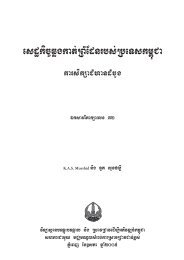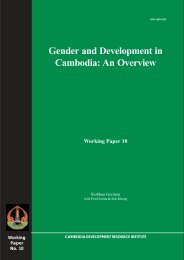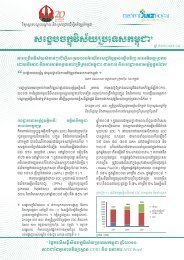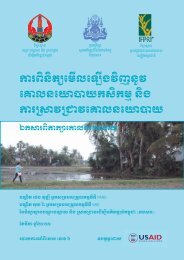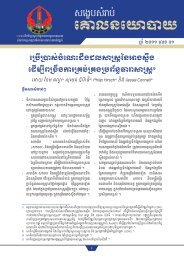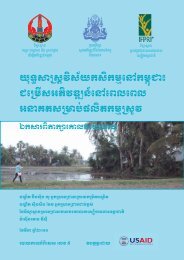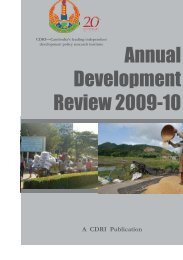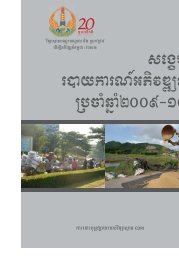62) decentralised governance of irrigation water in cambodia - CDRI
62) decentralised governance of irrigation water in cambodia - CDRI
62) decentralised governance of irrigation water in cambodia - CDRI
You also want an ePaper? Increase the reach of your titles
YUMPU automatically turns print PDFs into web optimized ePapers that Google loves.
CHAPTER 5 FINDINGS<br />
5.1 Introduction to F<strong>in</strong>d<strong>in</strong>gs<br />
Water <strong>governance</strong> manifests differently <strong>in</strong> each <strong>of</strong> the case study schemes. This is due<br />
to a number <strong>of</strong> factors <strong>in</strong>clud<strong>in</strong>g differences <strong>in</strong> scale, physical <strong>in</strong>frastructure and structure<br />
<strong>of</strong> <strong>water</strong> <strong>governance</strong> bodies, farmer participation and coord<strong>in</strong>ation, <strong>in</strong>ternal capacity <strong>of</strong> the<br />
FWUC committees, and external support for the FWUCs <strong>in</strong> <strong>in</strong>dividual schemes. F<strong>in</strong>d<strong>in</strong>gs from<br />
<strong>in</strong>terviews and field observations are presented <strong>in</strong> the context <strong>of</strong> how <strong>irrigation</strong> systems are<br />
actually governed and managed <strong>in</strong> rural Cambodia, and the extent to which local people are<br />
<strong>in</strong>volved <strong>in</strong> scheme management. This chapter is divided <strong>in</strong>to three themes that encompass<br />
the <strong>in</strong>formation gathered from the <strong>in</strong>terviewees: actual <strong>governance</strong> arrangements, farmer<br />
participation, and stakeholder coord<strong>in</strong>ation. The four elements <strong>of</strong> <strong>irrigation</strong> <strong>governance</strong><br />
(system ma<strong>in</strong>tenance, <strong>water</strong> allocation, coord<strong>in</strong>ation and conflict management), as identified<br />
<strong>in</strong> the research questions <strong>of</strong> this study, transcend the thematic divisions <strong>of</strong> this chapter and are<br />
addressed as case study examples throughout the chapter.<br />
5.2 Actual Governance Arrangements<br />
5.2.1 Legitimacy <strong>of</strong> FWUCs<br />
The recognition <strong>of</strong> FWUC legitimacy was strongest at PDOWRAM level; villagers and<br />
MOWRAM did not always fully recognise the FWUC committee as a legitimate <strong>governance</strong><br />
body. The FWUCs <strong>in</strong> DAP and Stung Ch<strong>in</strong>it are formally registered with MOWRAM.<br />
Rolous has had an operational FWUC s<strong>in</strong>ce 2004, and has already held three elections for its<br />
committee members (<strong>in</strong> 2004, 2007 and 2010 14 ); however, it has not yet been registered with<br />
MOWRAM even though it is formally recognised by the villagers and PDOWRAM. A Rolous<br />
FWUC representative reported that all requirements stated <strong>in</strong> the FWUC establishment statute<br />
were fulfilled, but the budgetary limitations <strong>of</strong> both the FWUC and PDOWRAM meant that<br />
a MOWRAM representative was not <strong>in</strong>vited to attend the election. Although recognis<strong>in</strong>g the<br />
existence <strong>of</strong> the FWUC committee as a <strong>governance</strong> body, some farmers expla<strong>in</strong>ed that because<br />
<strong>of</strong> the lack <strong>of</strong> formal written registration from MOWRAM they had little trust <strong>in</strong> the FWUC<br />
committee’s ability to manage the scheme. These feel<strong>in</strong>gs were “validated” by the FWUC<br />
committee’s <strong>in</strong>adequate action <strong>in</strong> the wake <strong>of</strong> the Ketsana storm <strong>in</strong> 2009 and its <strong>in</strong>ability to<br />
demonstrate technical and agricultural capability.<br />
An <strong>in</strong>terview with PDOWRAM representatives <strong>in</strong> Pursat revealed that donor agencies<br />
had advised that a policy be set <strong>in</strong> place to prevent community members already hold<strong>in</strong>g<br />
positions <strong>of</strong> authority (e.g., CC members) from be<strong>in</strong>g elected as FWUC committee members 15 .<br />
This advice had been fairly <strong>in</strong>fluential until recently. The newly established FWUC <strong>in</strong> DAP<br />
has seven CC members, one from each <strong>of</strong> the communes with<strong>in</strong> the command area. The Pursat<br />
PDOWRAM justified this, say<strong>in</strong>g that the CC representatives are “well known and popular,<br />
have had management experience, have displayed good leadership <strong>in</strong> the past, own rice paddies<br />
<strong>in</strong> the command area and have an adequate economic situation”. Based on these factors, a<br />
14 The most recent election was conducted <strong>in</strong> May 2010; a PDOWRAM staff member was <strong>in</strong>vited/attended<br />
(communication with FWUC leader <strong>in</strong> Rolous, 1 April 2011).<br />
15 This was not <strong>in</strong>cluded <strong>in</strong> the guidel<strong>in</strong>es on FWUC establishment.<br />
<strong>CDRI</strong> Work<strong>in</strong>g Paper Series No. <strong>62</strong><br />
19



